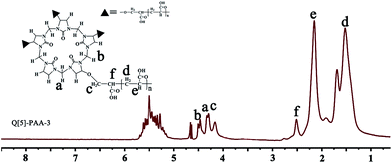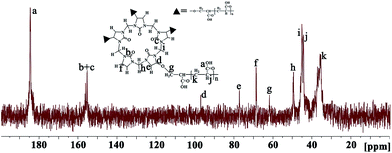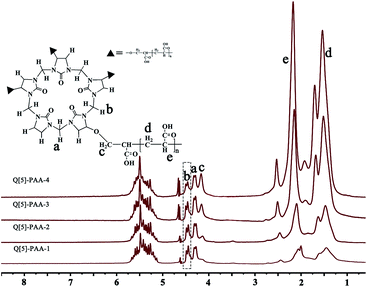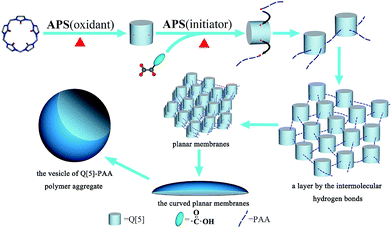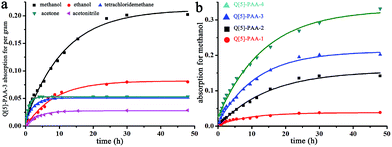Direct synthesis of cucurbit[5]uril-anchored polyacrylic acid microspheres and potential applications in selective sorption†
Bo Xiaoa,
Ying Fana,
Rui-han Gaoa,
Peng Chena,
Jian-xin Zhangb,
Qing-di Zhouc,
Sai-Feng Xuea,
Qian-Jiang Zhu*a and
Zhu Tao*a
aGuizhou University, Key Laboratory of Macrocyclic and Supramolecular Chemistry of Guizhou Province, Guiyang 550025, PR China. E-mail: zqjgzu@126.com
bThe Key Laboratory of Chemistry for Natural Products of Guizhou Province and Chinese Academy of Sciences, Guiyang 550002, PR China
cSchool of Chemistry, The University of Sydney, Australia
First published on 7th April 2015
Abstract
A one-pot strategy was employed to synthesize a series of cucurbit[5]uril-anchored (Q[5]-anchored) polymers with high yields. The acrylic acid (AA) monomer, an ammonium persulfate salt (APS) initiator, and an oxidant were used in the polymerization. The Q[5]-anchored polyacrylic acid aggregates (Q[5]-PAA) have been characterized by 1H NMR, 13C NMR, 2D NMR, FTIR, TGA, GPC, TEM and SEM measurements. The experimental results confirm that PAA chains can be grafted to Q[5] in a controlled manner through an in situ radical polymerization approach. The effects of acrylic acid and Q[5] feed mass and APS concentration on the formation of polymer nanocapsules have been investigated. The experiments reveal that the feed mass of acrylic acid greatly influences the properties of Q[5]-PAA when the ratio of Q[5]/APS is fixed at 0.5. In particular, when APS/Q[5] = 46 and 72, vesicle structures are observed in the Q[5]-anchored polymers. Moreover, such polymer nanocapsules show selective absorption of some volatile compounds, particularly methanol.
Introduction
Kim and co-workers reported a facile route for synthesizing a derivative of cucurbit[n]uril (Q[n]), perhydroxycucurbit[n]urils ((OH)2nQ[n]s).1 That study allows a wide variety of functional groups to be incorporated into Q[n]s2–11 via direct functionalization. Q[n]-based nanometer-sized hollow polymer spheres or polymer nano-capsules are important for a wide range of applications including drug delivery, encapsulation, and imaging.12–14 Generally, to synthesize Q[n]-based polymers, Q[n]s must first be oxidised to ((OH)2nQ[n]s), and then functionalized with various groups that can be polymerized to form the Q[n]-based polymers.15–22 This method appears to be applicable to any Q[n],1 and the polymer shell allows facile tailoring of its surface properties in a noncovalent and modular manner via accessible molecular cavities exposed on the surface. However, poor yields could frustrate the development of Q[n]-based polymers. For example, Q[6] systems generally have the highest yields, with 45% oxidation yield, 70% fictionalization yield, and 70% polymerization yield amounting to a total yield of 20%. For larger Q[n]s, such as Q[7] and Q[8], the oxidation yield is 4–5%, and the total yield is only 2%. Moreover, the oxidation method is only suitable for unsubstituted Q[n]s, because attempts to oxidise alkyl-substituted Q[n]s have all failed. In 2013, Su and co-workers demonstrated a one-pot, direct method for the preparation of Q[6]-anchored acrylamide polymers without functionalizing Q[6],23 which is applicable for monomers used in radical polymerization in aqueous solution. This research holds great promise for the development of a facile method for the synthesis of other Q[n]-anchored polymers besides Q[6]. To prove the practicality and feasibility of this method, a series of Q[n]s, including unsubstituted Q[n] (n = 5, 7, 8), and a partially alkyl-substituted Q[6] were selected to synthesize a series of Q[n]-anchored polyacrylamides in aqueous solution using a potassium persulfate salt as both an initiator and an oxidant. Experimental results have shown that this one-pot strategy is an effective method for functionalizing various Q[n]s with high yields (total yield = 50–70%), and is especially effective for those that are susceptible to decomposition. Thus, using this synthetic strategy, Q[n]-anchored polymers with honeycomb or linear conformations could be synthesized in a controlled manner by introducing Q[n]s with specific structural features, such as 1,3,5-HMeQ[6] and 1,3,5-triCyHQ[6]. The investigation of Su's one-pot strategy for Q[n]-anchored polymers provides an exciting challenge for future Q[n]-based polymer chemistry.23,24 In the present work, Q[5] is selected as the anchor, acrylic acid (AA) is selected as the monomer with an active group (carboxyl group), and APS is the initiator and oxidant. Experiments reveal that microsphere aggregates of Q[5] anchored on PAA can be been synthesized in a one-pot free-radical polymerization that is initiated and oxidized by ammonium persulfate. The Q[5]-anchored PAAs with higher feed mass of AA are characteristic of vesicle structure feature, and show selective absorption for volatile substances, in particular, the methanol. Moreover, it is the first time that a Q[5]-anchored PAA with reactive groups has been synthesized by using the one-pot strategy.23,24 Furthermore, the carboxylic groups on the water soluble Q[5]-PAA polymers could be further functionalized, for example, esterified with celluloses to gain water-insoluble Q[5]-PAA polymers derivatives, which could be used as stationary phase materials for isolate metal ions organic molecules and so on.Results and discussion
Using a one-pot strategy, AA was polymerized in the presence of ammonium persulfate salt (APS) as an initiator and oxidant to produce Q[5]-anchored PAA.23,24 Four Q[5]-PAA via free radical polymerization in aqueous solution using APS were selected as typical samples to illustrate the features of the Q[5]-PAA (Table 1). The four samples were synthesized under identical conditions with constant feed masses of Q[5] (0.5 g, 0.05 mmol) and ammonium persulfate (0.57 g, 0.25 mmol), but the feed mass of acrylic acid was increased gradually, as shown in Table 1.| Sample | AA (0.4 mol L−1) | Grafting degree of Q[5] | PAA/Q[5] | Mw (g mol−1) | Dispersity |
|---|---|---|---|---|---|
| Q[5]-PAA-1 | 12.5 mL | 0.47 | 12![[thin space (1/6-em)]](https://www.rsc.org/images/entities/char_2009.gif) : :![[thin space (1/6-em)]](https://www.rsc.org/images/entities/char_2009.gif) 1 1 |
16![[thin space (1/6-em)]](https://www.rsc.org/images/entities/char_2009.gif) 295 295 |
2.78 |
| Q[5]-PAA-2 | 25 mL | 0.45 | 21![[thin space (1/6-em)]](https://www.rsc.org/images/entities/char_2009.gif) : :![[thin space (1/6-em)]](https://www.rsc.org/images/entities/char_2009.gif) 1 1 |
19![[thin space (1/6-em)]](https://www.rsc.org/images/entities/char_2009.gif) 107 107 |
2.21 |
| Q[5]-PAA-3 | 50 mL | 0.40 | 46![[thin space (1/6-em)]](https://www.rsc.org/images/entities/char_2009.gif) : :![[thin space (1/6-em)]](https://www.rsc.org/images/entities/char_2009.gif) 1 1 |
45![[thin space (1/6-em)]](https://www.rsc.org/images/entities/char_2009.gif) 569 569 |
1.61 |
| Q[5]-PAA-4 | 100 mL | 0.39 | 72![[thin space (1/6-em)]](https://www.rsc.org/images/entities/char_2009.gif) : :![[thin space (1/6-em)]](https://www.rsc.org/images/entities/char_2009.gif) 1 1 |
47![[thin space (1/6-em)]](https://www.rsc.org/images/entities/char_2009.gif) 870 870 |
1.60 |
NMR of Q[5]-anchored PAA
Fig. 1 shows the 1H NMR spectrum of the obtained Q[5]-PAA-3 polymer in D2O as a typical example. Relatively broad proton signals between 1.2–1.8 and 1.8–2.4 ppm are attributed to methylene protons (d) and methine protons (e) of the PAA segment, respectively (see the inset in Fig. 1). The proton signals at ∼2.5 and ∼4.2 ppm can be ascribed to protons (f) and methine protons (c) of the PAA moiety that bridges Q[5] moieties and the PAA segment, which can be confirmed by the gCOSY spectrum shown in Fig. S1 of the ESI.† The signal at ∼4.3 ppm can be assigned to the methylene protons of ungrafted units (Fig. 1a), and the singlets at ∼4.4 ppm can be assigned to the methylene protons of grafted units (Fig. 1b).23,24 The 13C NMR spectrum in Fig. 2 shows a carbonyl carbon signal (a) from carboxyl groups at ∼185 ppm, and resonances (b and c) of two different carbonyl carbons from grafted (b) and ungrafted (c) glycoluril units at ∼157 and ∼156 ppm, respectively. The HMQC NMR spectrum of Q[5]-PAA-3 polymer (Fig. S2 in the ESI†) can assist in fully assigning the carbon signals in Fig. 2: 97.4 ppm for (d), 77.5 ppm (e), 69.1 ppm (f) attributed to three waist carbons of Q[5]. Moreover, the cross peaks at 4.27/49.7 and 4.44/45.4 ppm can be assigned to methylenes close to ungrafted and grafted units, respectively. The cross peaks at 4.12/62.2 and 2.47/34.8 ppm (overlapped) correspond to the bridged AA moiety. The cross peaks at lower fields can be assigned to the PAA segment of the polymer.The feed mass of AA is an important influence on the properties of Q[5]-PAA polymers. Fig. 3 shows the 1H NMR spectra of the Q[5]-PAA polymers (Fig. 3). The average molar ratios of PAA to Q[5] (PAA/Q[5]) and the average molar ratios of grafted glycoluril units to the total number of glycoluril units of Q[5] (average grafting degree of Q[5]) can be obtained from the integral intensities of the corresponding proton resonances in the 1H NMR spectra and are listed in Table 1. The average grafting degree decreases with increasing of feed mass of AA, whereas the PAA/Q[5] ratio and the Mw increase with increasing feed mass of AA.
The Q[5]-PAA samples also characterized by FTIR and TGA. Because the carbonyl bands of PAA overlap with the carbonyl bands of Q[5], the FTIR spectrum of the Q[5]-PAA shows a broadened characteristic peak at ∼1750 cm−1 (Fig. S3 in the ESI†). A combination of DTA and TGA experiments show four main stages in the thermal behavior of Q[5]-PAA. The first stage, between room temperature and 150 °C, shows peak at ∼100 °C, corresponding to the release of desorbing water molecules. The next two stages occur between 200 °C and 450 °C, with peaks at approximately 285 °C and 375 °C resulting from the decomposition of acid groups on grafted PAA chains and the decomposition of grafted PAA in the Q[5]-PAA. The final transition is observed between 450 °C and 600 °C with a peak at near 500 °C, which could be assigned to the decomposition of Q[5] groups in the Q[5]-PAA since it is similar to the decomposition temperature of neat Q[5] (Fig. S4 in the ESI†).
Size and morphology of Q[5]-anchored PAA
The size and morphology of the polymer aggregates greatly influence their applicability. The morphology of Q[5]-PAA polymer samples were studied using TEM and SEM measurements. Fig. 4 shows representative micrographs of typical Q[5]-PAA polymer aggregates for the four samples under the same condition. The sizes of the aggregates seem to increase and become spherical with increasing feed mass of AA. Only planar lamellae are observed in samples 1 and 2, whereas vesicles of microspherical aggregates with diameters of ∼1 μm are observed in Q[5]-PAA-3 and Q[5]-PAA-4. The thickness of the membrane is approximately 20–30 nm. The four Q[5]-PAA polymers with different feed masses of AA show obvious differences in size and morphology.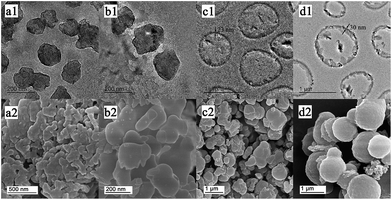 | ||
| Fig. 4 Aggregate morphologies of Q[5]-PAA-1 (a1, TEM; a2, SEM), Q[5]-PAA-2 (b1, TEM; b2, SEM), Q[5]-PAA-3 (c1, TEM; c2, SEM), Q[5]-PAA-4 (d1, TEM; d2, SEM). | ||
According to the theoretical model reported by Israelachvili and co-workers25 and the Q[6]-based polymer nanocapsules reported by Kim and co-workers,26 vesicles of Q[5]-PAA microsphere aggregates seem to form when the ratio of PAA/Q[5] ratio is over 40 and the grafting degree is about 0.40. We can infer the process of microspherical aggregate formation as follows. In vesicles of Q[5]-PAA microspherical aggregates, PAA forms long chains that link the Q[5] moieties, while the Q[5] moieties in the polymers contain more grafted glycoluril units. The possible conformation of Q[5]-PAA-based planar layers is shown in Fig. 5, and includes the formation of a layer through intermolecular hydrogen bonding between acid groups and carbonyl group of Q[5] portals. These layers stack to form the planar membranes. Such planar membranes begin to bend to reduce their total energy, and finally vesicles are the preferred structures.
Sorption properties of Q[5]-anchored PAA
Considering the inner walls of the channels of the Q[5]-PAA-based porous membranes are decorated with protruding carbonyl oxygens of Q[5] and carboxyls of PAA. The polarity and the size are dominant factors in determining selectivity to different volatile substances. Therefore, sorption experiments were conducted to determine preferential sorption behavior.Fig. 6a shows sorption profiles for several volatile solvents on the Q[5]-PAA-3 polymer, and shows a selective sorption capacity of >20 wt% for methanol, while only ∼3 wt% for acetonitrile at 25 °C, 0.89 atm. The sorption capacity of the Q[5]-PAA-3 for other solvents are 8% for ethanol, 5.3% for acetone, and 5.18% for tetrachloride methane. The sorption capacity of Q[5]-PAA-3 shows enhanced selectivity for methanol, which could be attributed to intermolecular hydrogen bonding between the hydroxyls of methanol and the portal carbonyl oxygens of Q[5]. The sorption of ethanol was second highest due to the existence of similar hydrogen bonding. The average channel size of Q[5]-PAA polymers could increase with increasing of feed mass of AA. The methanol sorption experiments for each Q[5]-PAA polymer confirm this hypothesis (Fig. 6b). The methanol sorption capacities for the Q[5]-PAA samples are 33.1% for Q[5]-PAA-4, 20.8% for Q[5]-PAA-3, 14.2% for Q[5]-PAA-2, and 3.8% for Q[5]-PAA-1. Similar results for acetonitrile are shown in Fig. S5 in the ESI.† Lifetime tests of the Q[5]-PAA-3 polymer shown in Fig. S6 of the ESI† suggest that the Q[5]-PAA-3 polymer is quite stable.
Experimental
Materials
Q[5] was prepared according to methods previously reported in the literature.27,28 Ammonium persulfate (AR) and AA (AR) were obtained from the Aladdin Industrial Corporation (Naoqiao Town, Fengxian Shanghai, China).Synthesis of Q[5]-anchored PAA
As a typical example, Q[5]-PAA-3 is synthesized by dissolving, Q[5] (0.5 g, 0.05 mmol) and ammonium persulfate (0.57 g, 0.25 mmol) in distilled water (25 mL). The solution was stirred with a small magnetic stir bar under an inert nitrogen atmosphere and heated to 75 °C in a water bath. After thermal equilibrium had been reached and N2 had been bubbled through the solution for 1 h, a 0.4 mol L−1 aqueous solution of acrylic acid (50 mL, 2 mmol) was added by drop-wise. After stirring the reaction mixture for another 8 h, the solution was cooled to room temperature. The resulting precipitate (salts formed during reaction) was removed by filtration. The filtrate was purified by dialysis (MWCO 2000) against water for 24 h to yield a polymer solution, and then concentrated to a volume of 2 mL on a rotary evaporator. The product was precipitated from the concentrated solution by the addition of acetone, and purified by three dissolution–precipitation cycles. The white precipitate was washed three times with acetone. The final precipitate was collected, immersed in acetone for 4 h, and then dried under reduced pressure at 40 °C for 48 h. The yield was ∼55%. Other Q[5]-anchored polyacrylic acid samples were synthesized under similar conditions except with varying feed masses of acrylic acid (yields = 50–70%). The detailed conditions are listed in Table 1.Characterization
All NMR spectra, including those for titration experiments, were recorded at 20 °C on a VARIAN INOVA-400 spectrometer. D2O was used as a field-frequency lock, and the observed chemical shifts are reported in parts per million (ppm) relative to an internal standard (TMS at 0.0 ppm).Fourier transform infrared (FTIR) spectra were acquired on a VERTEX 70 FTIR spectrometer from samples in KBr pellets. The spectra were acquired over the frequency range 4000−400 cm−1 at a resolution of 4 cm−1 from a total of 16 scans.
The thermal characteristics of the prepared samples were determined by a thermogravimetric analyzer (TGA). Samples were analyzed with a STA409PC TGA system (Netzsch, Germany). The analyses were performed with approximately 10 mg portions of dried sample in a dynamic nitrogen atmosphere (flow rate 50 mL min−1) at a heating rate of 10 °C min−1.
Transmission electron microscopy (TEM) images were recorded on a Hitachi JEM-2100 electron microscope operated at 200 kV. Samples were dispersed in solutions of 0.1 M sodium sulfate before being immobilized on copper grids. The samples were dried at room temperature.
Scanning electron microscopy (SEM) images were recorded out on a Hitachi S-4800 II field-emission SEM. Samples were dispersed in acetone immobilized on silicon wafers, and allowed to dry under reduced pressure at 40 °C for several hours.
Gel permeation chromatography (GPC) measurements were carried out in 0.3 M sodium nitrate solution eluent (pH 6.8, 1 mL min−1) at 45 °C using a PL-GPC50 from Agilent with a refractive index detector. The reference solution was glucan (Mw = 2.73 × 106) at the concentration of 6.75 mg ml−1.
Conclusions
In summary, microspherical aggregates of cucurbit[5]uril anchored on PAA were synthesized by using a one-pot free radical polymerization strategy in which ammonium persulfate was employed as an initiator and oxidant. NMR analysis reveals that structural features and properties of the Q[5]-PAA polymers can be controlled by the feed mass of AA at a 0.5 molar ratio of APS/active sites of Q[5]. According to TEM and SEM measurements, vesicles of different sizes and spherical morphology are observed when the ratio of PAA/Q[5] is greater than 40 and the grafting degree is approximately 0.40. One of the interesting properties of the Q[5]-anchored polymer is the selectivity for different volatile substances. Exploration of new properties of Q[5]-PAA polymers are ongoing.Acknowledgements
We acknowledge the support of the National Natural Science Foundation of China (nos 21272045, 51463004), the “Chun-Hui” Funds of the Chinese Ministry of Education (no. Z2014093) and the Natural Science Foundation of the Department of Education of Guizhou Province.Notes and references
- S. Y. Jon, N. Selvapalam, D. H. Oh, J. K. Kang, S. Y. Kim, Y. J. Jeon, J. W. Lee and K. Kim, J. Am. Chem. Soc., 2003, 125, 10186 CrossRef CAS PubMed.
- A. Flinn, G. C. Hough, J. F. Stoddart and D. J. Williams, Angew. Chem., Int. Ed., 1992, 31, 1475 CrossRef PubMed.
- J. Z. Zhao, H. J. Kim, J. Oh, S. Y. Kim, J. W. Lee, S. Sakamoto, K. Yamaguchi and K. Kim, Angew. Chem., Int. Ed., 2001, 40, 4233 CrossRef CAS.
- S. Sasmal, M. K. Sinha and E. Keinan, Org. Lett., 2004, 6, 1225 CrossRef CAS PubMed.
- L. B. Lu, Y. Q. Zhang, Q. J. Zhu, S. F. Xue and Z. Tao, Molecules, 2007, 12, 716 CrossRef CAS.
- F. Wu, L. H. Wu, X. Xiao, Y. Q. Zhang, S. F. Xue, Z. Tao and A. I. Day, J. Org. Chem., 2012, 77, 606 CrossRef CAS PubMed.
- H. Isobe, S. Sato and E. Nakamura, Org. Lett., 2002, 4, 1287 CrossRef CAS PubMed.
- A. I. Day, A. P. Arnold and R. J. Blanch, Molecules, 2003, 8, 74 CrossRef CAS PubMed.
- Y. J. Zhao, S. F. Xue, Q. J. Zhu, Z. Tao, J. X. Zhang, Z. B. Wei, L. S. Long, M. L. Hu, H. P. Xiao and A. I. Day, Chin. Sci. Bull., 2004, 49, 1111 CrossRef CAS.
- L. M. Zheng, J. N. Zhu, Y. Q. Zhang, Z. Tao, S. F. Xue, Q. J. Zhu, Z. B. Wei and L. S. Long, Chin. J. Inorg. Chem., 2005, 21, 1583 CAS.
- X. Q. Jiang, X. Y. Yao, X. H. Huang, Q. C. Wang and H. Tian, Chem. Commun., 2015, 51, 2890 RSC.
- W. Meier, Chem. Soc. Rev., 2000, 29, 295 RSC.
- D. G. Shchukin and G. B. Sukhorukov, Adv. Mater., 2004, 16, 671 CrossRef CAS PubMed.
- C. S. Peyratout and L. DIhne, Angew. Chem., Int. Ed., 2004, 43, 3762 CrossRef CAS PubMed.
- N. B. Cramer, J. P. Scott and C. N. Bowman, Macromolecules, 2002, 35, 5361 CrossRef CAS.
- C. E. Hoyle, T. Y. Lee and T. Roper, J. Polym. Sci., Part A: Polym. Chem., 2004, 42, 5301 CrossRef CAS PubMed.
- N. B. Cramer, S. K. Reddy, M. Cole, C. Hoyle and C. N. Bowman, J. Polym. Sci., Part A: Polym. Chem., 2004, 42, 5817 CrossRef CAS PubMed.
- W. L. Mock, Comprehensive Supramolecular Chemistry: Cucurbituril, ed. F. VKgtle, Pergamon, Oxford, 1996, vol. 2, pp. 477–493 Search PubMed.
- J. W. Lee, S. Samal, N. Selvapalam, H. J. Kim and K. Kim, Acc. Chem. Res., 2003, 36, 621 CrossRef CAS PubMed.
- J. Lagona, P. Mukhopadhyay, S. Chakrabarti and L. Isaacs, Angew. Chem., Int. Ed., 2005, 44, 4844 CrossRef CAS PubMed.
- K. Kim, N. Selvapalam, Y. H. Ko, K. M. Park, D. Kim and J. Kim, Chem. Soc. Rev., 2007, 36, 267 RSC.
- W. Jin, T. Fukushima, A. Kosaka, M. Niki, N. Ishii and T. Aida, J. Am. Chem. Soc., 2005, 127, 8284 CrossRef CAS PubMed.
- X. L. Huang, F. L. Hu and H. Q. Su, Macromolecules, 2013, 46, 1274 CrossRef CAS.
- B. Xiao, Y. Fan, N. N. Ji, X. J. Cheng, C. Z. Wang, J. J. Zhou, S. F. Xue, Z. Tao and Q. J. Zhu, Supramol. Chem., 2015, 27, 4 CrossRef CAS.
- J. N. Israelachvili, Intermolecular and Surface Forces, Academic Press, London, 2011 Search PubMed.
- D. Kim, E. Kim, J. Lee, S. Hong, W. Sung, N. Lim, C. Park and K. Kim, J. Am. Chem. Soc., 2010, 132, 9908 CrossRef CAS PubMed.
- A. I. Day and A. P. Arnold, Method for synthesis cucurbiturils, WO 0068232, 2000, 8.
- J. Kim, I. S. Jung, S. Y. Kim, E. Lee, J. K. Kang, S. Sakamoto, K. Yamaguchi and K. Kim, J. Am. Chem. Soc., 2000, 122, 540 CrossRef CAS.
Footnote |
| † Electronic supplementary information (ESI) available. See DOI: 10.1039/c5ra03418c |
| This journal is © The Royal Society of Chemistry 2015 |

